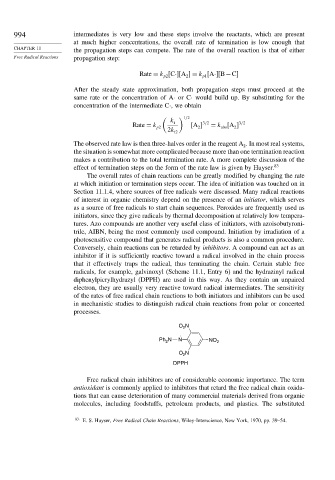Page 1010 - Advanced Organic Chemistry Part A - Structure and Mechanisms, 5th ed (2007) - Carey _ Sundberg
P. 1010
994 intermediates is very low and these steps involve the reactants, which are present
at much higher concentrations, the overall rate of termination is low enough that
CHAPTER 11 the propagation steps can compete. The rate of the overall reaction is that of either
Free Radical Reactions propagation step:
Rate = k C· A = k A· B−C
p1
p2
2
After the steady state approximation, both propagation steps must proceed at the
same rate or the concentration of A· or C· would build up. By substituting for the
concentration of the intermediate C·, we obtain
1/2
k i 3/2 3/2
Rate = k p2 A = k A
2
obs
2
2k t2
The observed rate law is then three-halves order in the reagent A . In most real systems,
2
the situation is somewhat more complicated because more than one termination reaction
makes a contribution to the total termination rate. A more complete discussion of the
effect of termination steps on the form of the rate law is given by Huyser. 83
The overall rates of chain reactions can be greatly modified by changing the rate
at which initiation or termination steps occur. The idea of initiation was touched on in
Section 11.1.4, where sources of free radicals were discussed. Many radical reactions
of interest in organic chemistry depend on the presence of an initiator, which serves
as a source of free radicals to start chain sequences. Peroxides are frequently used as
initiators, since they give radicals by thermal decomposition at relatively low tempera-
tures. Azo compounds are another very useful class of initiators, with azoisobutyroni-
trile, AIBN, being the most commonly used compound. Initiation by irradiation of a
photosensitive compound that generates radical products is also a common procedure.
Conversely, chain reactions can be retarded by inhibitors. A compound can act as an
inhibitor if it is sufficiently reactive toward a radical involved in the chain process
that it effectively traps the radical, thus terminating the chain. Certain stable free
radicals, for example, galvinoxyl (Scheme 11.1, Entry 6) and the hydrazinyl radical
diphenylpicrylhydrazyl (DPPH) are used in this way. As they contain an unpaired
electron, they are usually very reactive toward radical intermediates. The sensitivity
of the rates of free radical chain reactions to both initiators and inhibitors can be used
in mechanistic studies to distinguish radical chain reactions from polar or concerted
processes.
O N
2
.
Ph N N NO 2
2
O N
2
DPPH
Free radical chain inhibitors are of considerable economic importance. The term
antioxidant is commonly applied to inhibitors that retard the free radical chain oxida-
tions that can cause deterioration of many commercial materials derived from organic
molecules, including foodstuffs, petroleum products, and plastics. The substituted
83
E. S. Huyser, Free Radical Chain Reactions, Wiley-Interscience, New York, 1970, pp. 39–54.

